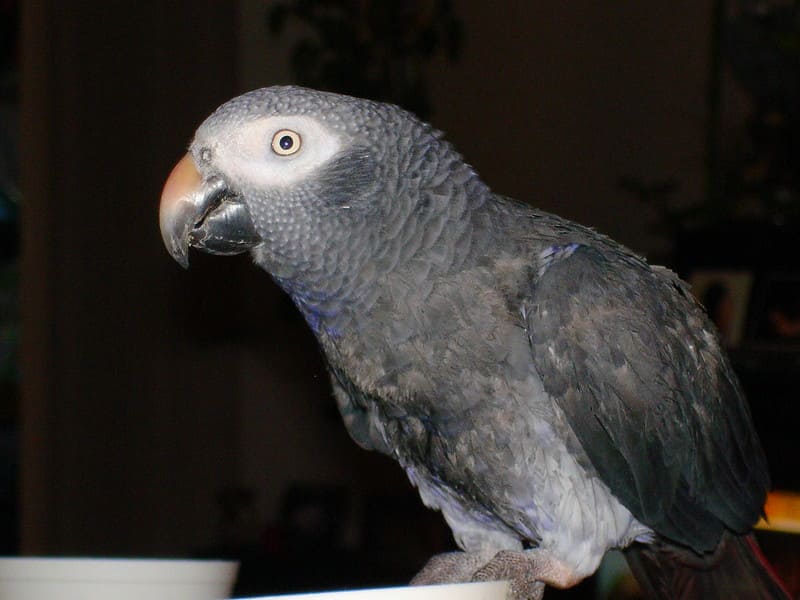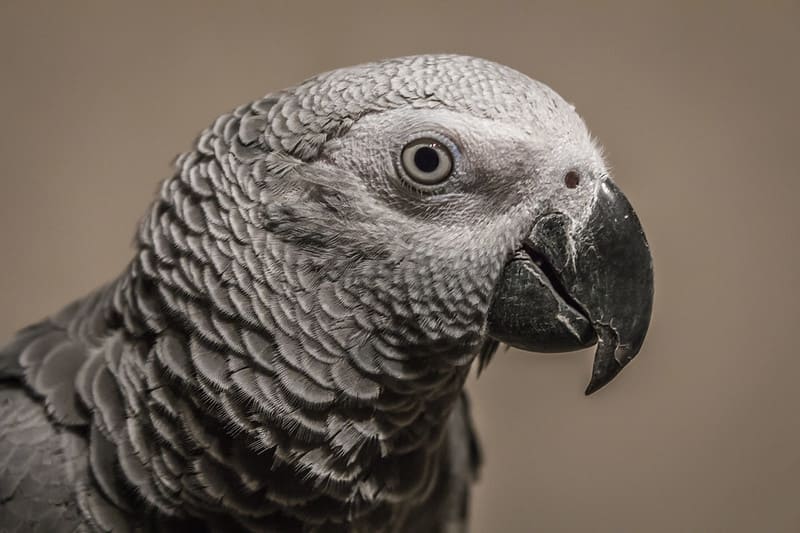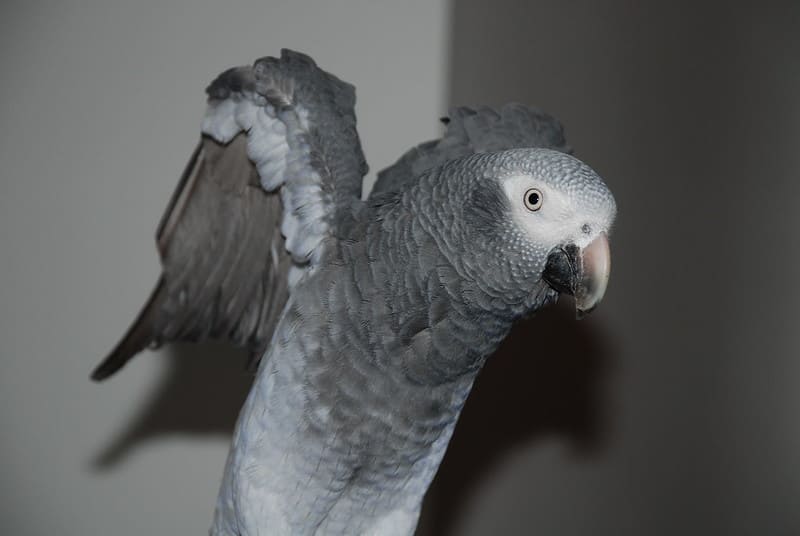African Grey Parrots, renowned for their exceptional intelligence and striking appearance, are among the most beloved and sought-after parrot species worldwide. However, there is an intriguing question that often perplexes both seasoned parrot enthusiasts and newcomers: Are there two types of African Grey Parrots? In this comprehensive article, we will delve into the world of African Grey Parrots, explore their distinct subspecies, and understand the characteristics and conservation status of these remarkable birds.

Introduction to African Grey Parrots
African Grey Parrots are medium-sized parrots belonging to the Psittacus genus. They are native to the rainforests of West and Central Africa and are celebrated for their high level of intelligence, remarkable mimicry skills, and striking appearance. African Grey Parrots are often divided into two primary species:
- Congo African Grey Parrot (Psittacus erithacus erithacus): This is the most commonly recognized African Grey species and is found in the western and central regions of Africa. It is often referred to simply as the “African Grey Parrot.”
- Timneh African Grey Parrot (Psittacus erithacus timneh): The Timneh African Grey is considered a distinct subspecies, primarily found in the western and upper western regions of West Africa.
These two types, the Congo and the Timneh African Grey Parrots, are the focus of our exploration.
The Congo African Grey Parrot (Psittacus erithacus erithacus)
Characteristics
The Congo African Grey Parrot, scientifically known as Psittacus erithacus erithacus, is the larger of the two African Grey species. These parrots are known for their striking grey plumage, vibrant red tail feathers, and a black beak. They have a distinctive white mask around their eyes and dark, reddish eyes, which give them an incredibly expressive and intelligent appearance.
Congo African Grey Parrots have a wingspan of about 18 inches (46 cm) and can weigh anywhere from 400 to 650 grams, depending on their age and sex. These parrots have a lifespan of approximately 40 to 60 years or even longer, making them long-term companions for those who care for them.
Intelligence and Mimicry Skills
One of the most remarkable features of Congo African Grey Parrots is their intelligence. They are often regarded as one of the most intelligent parrot species and, in some cases, as one of the most intelligent non-human animals. They have an impressive capacity to mimic human speech and sounds, and their ability to understand and use language has astounded researchers and bird enthusiasts alike.
Congo African Greys are known for their extensive vocabulary, clear pronunciation, and the ability to convey meaning through the use of words. They can develop a strong emotional connection with their human caregivers and may display exceptional problem-solving skills, adding to their reputation as a highly intelligent parrot species.
Personality
Congo African Grey Parrots are known for their complex and dynamic personalities. They are social birds that thrive on interaction and mental stimulation. These parrots enjoy playing, engaging with toys, and being part of the family’s daily activities. However, they can also be sensitive and may become stressed or agitated in response to changes in their environment.
Congo African Greys are known to form strong bonds with their human caregivers, and they may become emotionally attached to their owners. This emotional connection can be both rewarding and challenging, as it requires consistent attention and companionship to maintain the bird’s well-being.
Conservation Status
The Congo African Grey Parrot faces significant conservation challenges in the wild. The combination of habitat loss due to deforestation, illegal trapping for the pet trade, and ongoing threats to their native rainforest habitats has led to a decline in their numbers. They are listed as vulnerable by the International Union for Conservation of Nature (IUCN).
Efforts to protect and conserve Congo African Grey Parrots involve initiatives such as habitat preservation, anti-poaching measures, and captive breeding programs to reduce the pressure on wild populations. Conservation organizations and responsible parrot enthusiasts play a vital role in the protection of this remarkable species.

The Timneh African Grey Parrot (Psittacus erithacus timneh)
Characteristics
The Timneh African Grey Parrot, scientifically known as Psittacus erithacus timneh, is the smaller of the two African Grey species. These parrots have a generally dark grey plumage, featuring a darker charcoal grey body, maroon tail feathers, and a horn-colored upper beak.
Timneh African Greys have a wingspan of about 16 inches (41 cm) and typically weigh between 275 to 400 grams, making them noticeably smaller than their Congo counterparts. Their lifespan is also substantial, ranging from 30 to 50 years or more.
Intelligence and Mimicry Skills
Timneh African Grey Parrots share the remarkable intelligence and mimicry skills of their Congo relatives. They are capable of learning a wide range of words and phrases and are known for their clear, distinct pronunciation. While they may not have as extensive a vocabulary as Congo African Greys, they can be impressive talkers and communicators.
These parrots display an affinity for problem-solving and enjoy engaging in activities that stimulate their mental faculties. Timneh African Greys have an inquisitive nature, and their intelligence is a key aspect of their charm and appeal as pets.
Personality
Timneh African Grey Parrots have personalities characterized by a mixture of social interaction and independence. They enjoy interacting with their human caregivers, participating in activities, and engaging with toys. These birds also appreciate moments of solitude and may be more self-reliant than some other parrot species.
Timneh African Greys are known for their calm and gentle nature, making them suitable companions for individuals and families. They have a reputation for being less emotionally demanding than Congo African Greys and may adjust well to a variety of living situations.
Conservation Status
The Timneh African Grey Parrot, like the Congo African Grey, faces significant conservation challenges. Habitat loss due to deforestation and illegal trapping for the pet trade have led to a decline in their numbers. The IUCN classifies the Timneh African Grey Parrot as vulnerable as well.
Conservation efforts aimed at protecting the Timneh African Grey include initiatives similar to those for the Congo African Grey, such as habitat preservation, anti-poaching measures, and captive breeding programs.

Differentiating Between Congo and Timneh African Greys
Differentiating between Congo and Timneh African Greys can be challenging, especially for those who are not seasoned bird enthusiasts. Here are some key characteristics that can help distinguish the two species:
1. Size
Size is one of the most noticeable differences between the two species. Congo African Grey Parrots are larger, with a wingspan of around 18 inches, while Timneh African Grey Parrots are smaller, with a wingspan of approximately 16 inches.
2. Plumage
The color of the plumage can also help differentiate between the two. Congo African Greys have a bright grey body with vibrant red tail feathers, while Timneh African Greys have a darker grey body and maroon tail feathers.
3. Beak Color
The color of the upper beak can provide a clue. Congo African Greys have a black upper beak, while Timneh African Greys have a horn-colored upper beak.
4. Weight
Congo African Greys are typically heavier than Timneh African Greys. While weight alone may not be a reliable indicator, the size and weight together can help differentiate the two.
It’s important to note that there can be individual variation within each species, and hybridization between the two species can occur in captivity. As a result, identifying the specific type of African Grey Parrot may require the expertise of a knowledgeable avian veterinarian or an experienced parrot breeder.
The Parrot Trade and Conservation
The popularity of African Grey Parrots in the pet trade has been a major factor in their decline in the wild. These birds are sought after for their intelligence, remarkable mimicry skills, and striking appearance. The demand for African Greys has led to widespread trapping and illegal trade, resulting in declining populations in their native habitats.
Conservation efforts are essential to protect both the Congo and Timneh African Grey Parrots. These efforts encompass several key strategies:
1. Habitat Preservation
Preserving the rainforest habitats of African Grey Parrots is crucial for their survival. Conservation organizations and governments work to establish protected areas and combat deforestation.
2. Anti-Poaching Measures
Efforts to reduce illegal trapping and poaching are essential. Anti-poaching teams are deployed to protect parrot populations from capture for the pet trade.
3. Captive Breeding Programs
Captive breeding programs are instrumental in reducing the demand for wild-caught parrots. These programs aim to produce healthy, well-adjusted parrots for the pet trade and are an important aspect of conservation.
4. Public Awareness and Education
Raising public awareness about the plight of African Grey Parrots in the wild is crucial. Education initiatives inform the public about the importance of protecting these birds and their natural habitats.
5. Legal Protections
International and domestic legislation plays a role in safeguarding these parrots. Trade restrictions, import/export regulations, and legal protections are in place to combat illegal trade and trapping.
The Complex World of African Grey Parrots
African Grey Parrots, whether Congo or Timneh, inhabit a complex world characterized by their remarkable intelligence, intricate personalities, and their status as vulnerable species in the wild. Understanding the distinctions between these two types of African Greys is just the beginning of the journey for those who choose to care for these incredible birds.
The decision to bring an African Grey Parrot into your home is one that should be made with careful consideration of their specific needs, including mental stimulation, social interaction, and companionship. Whether Congo or Timneh, these parrots require dedicated care, a proper living environment, and an unwavering commitment to their well-being. Additionally, supporting conservation efforts and responsible trade practices is essential to ensuring the survival of African Grey Parrots in the wild.
As African Grey Parrots continue to capture the hearts of people around the world, the importance of protecting their natural habitats and ensuring their welfare in captivity becomes increasingly vital. In doing so, we can appreciate and safeguard the intelligence and beauty of these incredible birds for generations to come.
